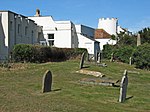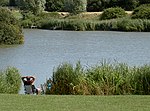Burnham-on-Sea Lifeboat Station
Burnham-on-SeaLifeboat stations in SomersetUse British English from March 2017

Burnham-on-Sea Lifeboat Station is the base for Royal National Lifeboat Institution (RNLI) search and rescue operations at Burnham-on-Sea, Somerset in England. A lifeboat was stationed in the town from 1836 until 1930. The present station was opened in 2003. It operates two inshore lifeboats (ILBs), a B Class rigid-inflatable boat and an inflatable D Class.
Excerpt from the Wikipedia article Burnham-on-Sea Lifeboat Station (License: CC BY-SA 3.0, Authors, Images).Burnham-on-Sea Lifeboat Station
Old Station Approach,
Geographical coordinates (GPS) Address Website External links Nearby Places Show on map
Geographical coordinates (GPS)
| Latitude | Longitude |
|---|---|
| N 51.2337 ° | E -2.9973 ° |
Address
Burnham-on-Sea Lifeboat Station
Old Station Approach
TA8 1DE , Burnham-on-Sea and Highbridge
England, United Kingdom
Open on Google Maps









